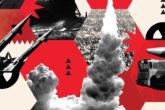March 18, 2025
Assessing China’s Nuclear Decision-Making
Three Analytical Lenses
Executive Summary
China’s rapid nuclear buildup is raising questions about how the country makes decisions related to nuclear weapons. This policy brief analyzes that trend by presenting three overarching analytical lenses, or categories of factors, that shape Beijing’s nuclear decision-making: leadership, weapons systems and military organizations, and official policies and doctrine.
On leadership, Chinese Communist Party General Secretary Xi Jinping likely sees nuclear weapons granting prestige and growing in relevance, but his views on nuclear weapons’ efficacy are less clear. On weapons systems and military organizations, the expansion of China’s nuclear arsenal provides the country’s leaders with new options, which could shift those leaders’ intentions over time. Implementation of those options, though, runs through often-corrupt People’s Liberation Army military organizations. On official policies and doctrine, Beijing possibly sees its professed stance as a country that does not engage in U.S.- and Russian-style arms buildups as a source of diplomatic influence, particularly in the developing world or Global South. Separately, the circumstances where China’s nuclear no-first-use policy would face a true test—for example, during a major Taiwan contingency—are precisely the moments when Beijing would have massive incentives to selectively interpret or simply abandon that policy.
In the near term, China’s official nuclear weapons policies will likely stay the same, so the gap between rhetoric and action will grow. A bigger arsenal and more nuclear rhetoric and signaling will, over time, also shape future Chinese coercion campaigns. In response, U.S. policymakers should commission an intelligence assessment of Xi’s views of specific nuclear crises, pressure China to issue more explanation of its nuclear policies and capabilities, and expand information sharing about missile tests on a reciprocal basis. U.S. policymakers should also make an authoritative policy statement on what would constitute China reaching nuclear parity with the United States and counter China’s nuclear buildup using both conventional and nuclear capabilities.
Introduction
The nuclear weapons arsenal of the People’s Republic of China (PRC) has grown rapidly in size and sophistication in recent years. The U.S. Department of Defense estimates that the country has 600 warheads in its inventory as of 2024, and those numbers are projected to increase to 1,000 by 2030 and continue growing well into the 2030s.1 In addition, Beijing is improving its triad of nuclear delivery systems comprising various types of missiles, submarines, and bomber aircraft. It has constructed hundreds of new missile silos, has tested new types of delivery systems, and is moving some forces to a launch-on-warning posture.
China’s nuclear buildup has led U.S. policymakers in the executive and legislative branches to question what the trend says about Beijing’s decision-making related to nuclear weapons.2 This policy brief offers a framework to answer those questions in a brisk and accessible way. It presents three overarching lenses, or categories of factors, that shape China’s nuclear decision-making: leadership, weapons systems and military organizations, and official policies and doctrine. The brief concludes with recommendations for U.S. policymakers in the executive and legislative branches.
Read the full report
- Military and Security Developments Involving the People’s Republic of China 2024 (Washington, D.C.: Department of Defense, December 18, 2024), 101–110, https://media.defense.gov/2024/Dec/18/2003615520/-1/-1/0/MILITARY-AND-SECURITY-DEVELOPMENTS-INVOLVING-THE-PEOPLES-REPUBLIC-OF-CHINA-2024.PDF. For a detailed treatment of changes to China’s nuclear arsenal, see Jacob Stokes, Atomic Strait: How China’s Nuclear Buildup Shapes Security Dynamics with Taiwan and the United States (Washington, D.C.: Center for a New American Security, February 7, 2023), https://www.cnas.org/publications/reports/atomic-strait-how-chinas-nuclear-buildup-shapes-security-dynamics-with-taiwan-and-the-united-states. ↩
- This report builds on the author’s earlier work examining China’s overall foreign and security policy decision-making under General Secretary Xi Jinping, namely Jacob Stokes, Beyond China’s Black Box: Five Trends Shaping Beijing’s Foreign and Security Policy Decision-Making Under Xi Jinping (Washington, D.C.: Center for a New American Security, April 30, 2024), https://www.cnas.org/publications/reports/beyond-chinas-black-box. ↩
More from CNAS
-
Beyond China's Black Box
China’s foreign and security policymaking apparatus is often described as a metaphorical black box about which analysts know little. That is true to an extent, but at the same...
By Jacob Stokes
-
Atomic Strait: How China’s Nuclear Buildup Shapes Security Dynamics with Taiwan and the United States
This report examines the intersection of China’s nuclear modernization and cross-Strait tensions, especially how they might play out during a crisis, contingency, or conflict ...
By Jacob Stokes
-
Indo-Pacific Security / Transatlantic Security / Technology & National Security
Averting AI ArmageddonIn recent years, the previous bipolar nuclear order led by the United States and Russia has given way to a more volatile tripolar one, as China has quantitatively and qualitat...
By Jacob Stokes, Colin H. Kahl, Andrea Kendall-Taylor & Nicholas Lokker
-
Over the Brink
A new era of nuclear deterrence is taking shape in the Indo-Pacific theater. As the People’s Republic of China (PRC) dramatically expands and modernizes its nuclear arsenal, t...
By Andrew Metrick, Philip Sheers & Stacie Pettyjohn
-
Avoiding the Brink
The United States is entering an unprecedented multipolar nuclear era that is far more complex and challenging than that of the Cold War. This report examines potential trigge...
By Stacie Pettyjohn & Hannah Dennis






